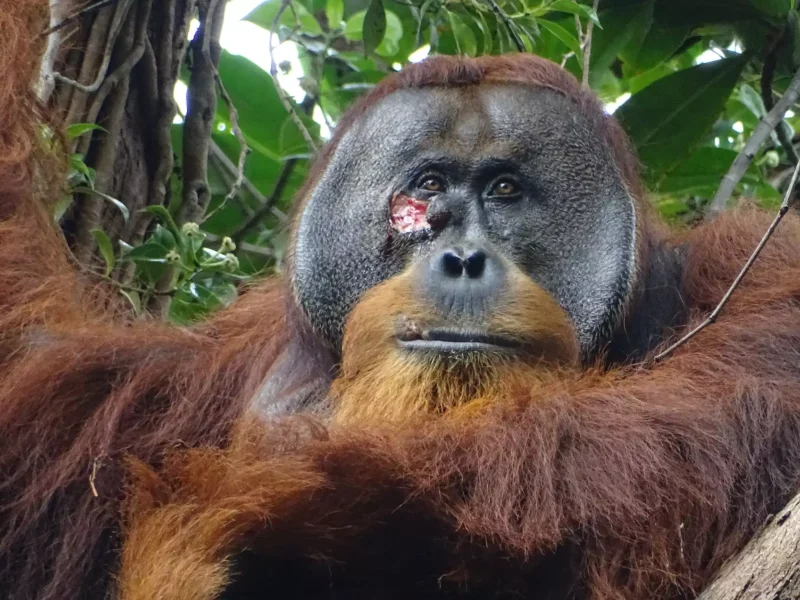For the first time, scientists have witnessed an animal treating its wounds with a medicinal plant. Cognitive and evolutionary biologists from the Max Planck Institute of Animal Behavior in Germany and Universitas Nasional in Indonesia said on May 2, 2024, that they were observing a Sumatran orangutan named Rakus when they saw him apply a plant with medicinal properties to a wound on his face. The orangutan ate a plant with known anti-inflammatory and pain-relieving properties. He also applied the sap and green plant mesh directly to his wound. It’s the first documentation of wound treatment by an animal with a biologically active substance.
The researchers published their study on May 2, 2024, in the peer-reviewed journal Nature, Scientific Reports.
Animal self-medication

Scientists have witnessed various sick and avoidance behaviors in animals before. Researchers have even seen animals ingest plant parts as a form of self-medication. But this type of wound treatment is new.
Sometimes orangutans accidentally touch plants while they’re feeding. It turns out that some of these plants have analgesic effects. So, as orangutans feel an immediate relief to the pain, they tend to repeat the same procedure, thereby treating their injuries.
Caroline Schuppli, one of the authors of the study, wrote:
Individuals may accidentally touch their wounds while feeding on this plant and thus unintentionally apply the plant’s juice to their wounds. As Fibraurea tinctoria has potent analgesic effects, individuals may feel an immediate pain release, causing them to repeat the behavior several times.
How this orangutan treated himself
Rakus had a wound on his face below his eye. It was probably the result of a fight with another male. But he took good care of it, like our early ancestors would have.
Rakus took some leaves from a climbing plant with the common name Akar Kuning (Fibraurea tinctoria). Then he chewed on them and precisely applied the sap to his wound several times. But that’s not all. This new doctor also fully covered the wound with the chewed leaves, protecting it from getting infected.
Isabelle Laumer, from the Max Planck Institute of Animal Behavior, and first author of the study, wrote about the plant:
This and related liana species that can be found in tropical forests of Southeast Asia are known for their analgesic and antipyretic effects and are used in traditional medicine to treat various diseases, such as malaria. Analyses of plant chemical compounds show the presence of furanoditerpenoids and protoberberine alkaloids, which are known to have antibacterial, anti-inflammatory, anti-fungal, antioxidant and other biological activities of relevance to wound healing.
So, Rakus did an excellent job because the wound healed and was completely closed in just five days, without infection. Also, Rakus rested more than usual while injured. Laumer explained:
Sleep positively affects wound healing, as growth hormone release, protein synthesis and cell division are increased during sleep.
Is Rakus the first orangutan of his kind?
Now, an interesting question comes to mind … If Rakus the Sumatran orangutan was aware of this plant’s properties and knew how to apply it to his wound, do other members of his species know about the treatment, too? Do they also possess this intentional behavior? According to Lamer:
The behavior of Rakus appeared to be intentional as he selectively treated his facial wound on his right flange, and no other body parts, with the plant juice. The behavior was also repeated several times, not only with the plant juice but also later with more solid plant material until the wound was fully covered. The entire process took a considerable amount of time.
The study took place at the Suaq Balimbing research site in Indonesia, which is a protected rainforest area. The sanctuary is home to approximately 150 critically endangered Sumatran orangutans. Scientists hadn’t observed this behavior before in the Suaq orangutan population. But, none of the Sumatran orangutans are born in Suaq. Schuppli explained:
Orangutan males disperse from their natal area during or after puberty over long distances to either establish a new home range in another area or are moving between other’s home ranges.
Schuppli added:
Therefore, it is possible that the behavior is shown by more individuals in his natal population outside the Suaq research area.
One smart ape, or many?
Only time and more studies will confirm if Rakus is a genius or if more great apes are capable of healing their wounds in this way. Apes already ingest specific plants to treat parasite infections and rub the plants on their skin to treat sore muscles. So maybe this is their next evolutionary step.
Orangutans are quite smart and can learn from watching their moms. Some of the skills they learn include where to find food, what to eat and how to eat it. They also learn how to build a proper sleeping nest. And some of these skills involve using special tools. It wouldn’t be surprising to see this behavior more often in the coming decades.
Bottom line: In a first, a Sumatran orangutan treated his wound with a plant with known medicinal properties. Read more about this new doctor in the forest.











